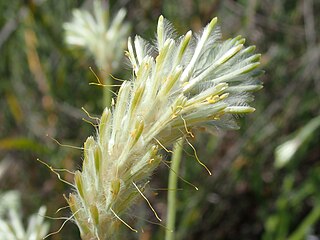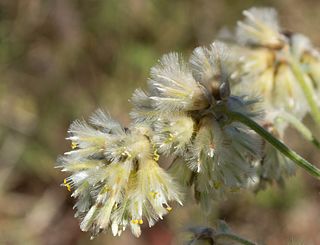
John McConnell Black was a Scottish botanist who emigrated to Australia in 1877 and eventually documented and illustrated thousands of flora in South Australia in the early 20th century. His publications assisted many botanists and scientists in the decades that followed. He was the younger brother of theatre and hotel manager Helen Carte.
Kevin R. Thiele is currently an adjunct associate professor at the University of Western Australia and the director of Taxonomy Australia. He was the curator of the Western Australian Herbarium from 2006 to 2015. His research interests include the systematics of the plant families Proteaceae, Rhamnaceae and Violaceae, and the conservation ecology of grassy woodland ecosystems. He also works in biodiversity informatics, developing and teaching the development of interactive multi-access keys, and has been involved in the design of software for the Global Biodiversity Information Facility.

Ptilotus is a genus of approximately 125 species of flowering plants in the family Amaranthaceae, and is endemic to Australia, apart from Ptilotus conicus that also occurs in Malesia. Plants in the genus Ptilotus are annual or perennial herbs or shrubs with usually hairy spikes of compact spherical, oval or cylindrical flowers.
Eryngium vaseyi, the coyote-thistle, is a species of flowering plant in the family Apiaceae. It is endemic to California. The specific epithet vaseyi honors the American plant collector George Richard Vasey, not to be confused with his father George S. Vasey.

Ptilotus nobilis, commonly known as yellow tails, is an annual or short-lived perennial herb of the family Amaranthaceae. It is found in arid regions of South Australia, southern and eastern Northern Territory, western Queensland and western New South Wales.

Pandorea doratoxylon is a species of woody vine in the family Bignoniaceae and is endemic to Australia. The species was first formally described in 1927 by John McConnell Black who gave it the name Tecoma doratoxylon in Transactions and Proceedings of the Royal Society of South Australia. In 1937, Black changed the name to Pandorea doratoxylon.

Ptilotus manglesii, commonly known as pom poms is a herb native to Western Australia. The Noongar name for the plant is mulla mulla.
Hansjörg Eichler was a German-born botanist, educated in Europe, who worked in Europe and Australia, and whose greatest contribution was to Australian botany.

Chenopodium desertorum, common name frosted goosefruit, is a species of flowering plant in the family Amaranthaceae, indigenous to Australia where it is found in all mainland states.

Ptilotus pyramidatus, the pyramid mulla mulla, is a small white herb in the family Amaranthaceae.

Ptilotus polystachyus is a perennial herb in the Amaranthaceae family.

Ptilotus schwartzii is a grass-like plant in the Amaranthaceae family.

Ptilotus divaricatus is a shrub in the Amaranthaceae family.

Ptilotus auriculifolius is an herb in the Amaranthaceae family.

Ptilotus humilis is an annual herb in the Amaranthaceae family, native to Western Australia. It was first described as Trichinium humile by Nees von Esenbeck in 1845 but was transferred to the genus, Ptilotus, by Ferdinand von Mueller in 1868.

Ptilotus latifolius, the tangled mulla mulla, is a perennial herb that is native to Australia, which grows abundantly on sand dunes and stony plains. The key diagnostic features of this plant are its very stem bound, shrub like appearance with densely clustered white white flowers with pink tips when newly blossomed. Each stem is generally supported by one to two leaves and the stems have a fluffy textures as well as the flowers. The petiole is generally long in this species and spike bound.
Ptilotus angustifolius, commonly known as regal fox tails, is a species of flowering plant in the family Amaranthaceae and is endemic to South Australia. It is a low, bushy herb with a several stems, narrowly egg-shaped leaves at the base of the plant, oval, intensely fragrant spikes of purple flowers and cylindrical heads of many long, hairy fruits.

Ptilotus aphyllus is a species of flowering plant in the family Amaranthaceae and is endemic to the a small area of inland Western Australia. It is a leafless perennial, except when young, and spikes of purple flowers fading to pink and pale orange.

Ptilotus appendiculatus is a species of flowering plant in the family Amaranthaceae and is endemic to the north of Western Australia. It is a prostrate perennial herb with egg-shaped leaves and spikes of pink flowers.
















